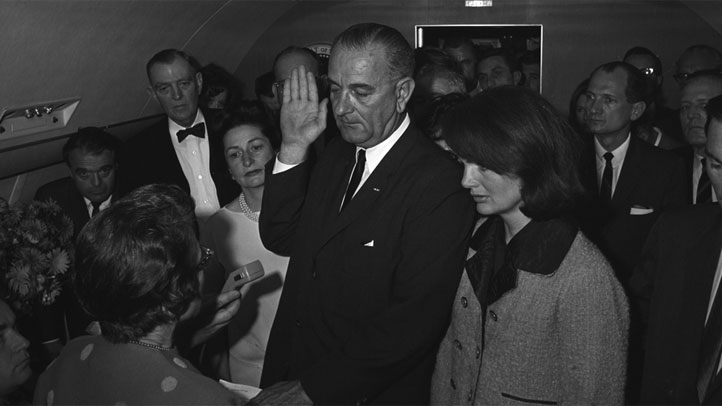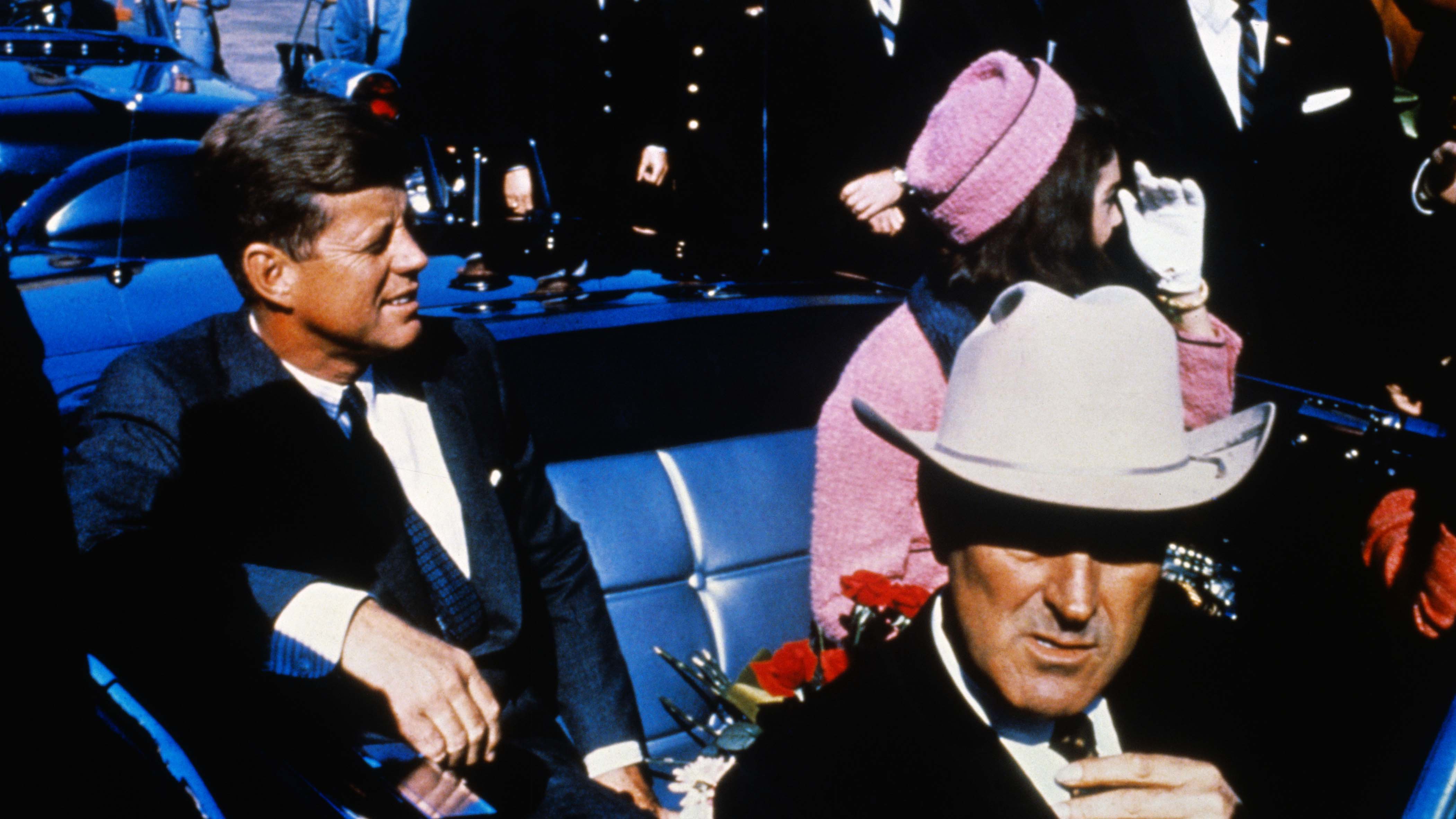President John F. Kennedy's assassination was one of the darkest days in the history of Dallas. Back in 1963, NBC 5's call letters were WBAP we were covering JFK's visit to Texas and when the president was shot, we broke into programming and stayed on the air for three days.
On the 60th anniversary of the assassination that changed Dallas and the nation, NBC 5 dug into our rich archives to bring you video from WBAP's coverage of the president's trip to both Fort Worth and Dallas as well as the days after the shots rang out in Dealey Plaza. One of our reporters and his photographer were at Dallas Police Headquarters when Jack Ruby fatally shot Lee Harvey Oswald.
NORTH TEXAS TRIP BEGINS IN FORT WORTH
President Kennedy's trip to North Texas started with a stop in Fort Worth where the president was scheduled to speak at a breakfast at the Fort Worth Chamber of Commerce.
Late in the evening on Nov. 21, 1963, Air Force One landed at Carswell Air Force Base, currently known as the Naval Air Station Joint Reserve Base Fort Worth. Air Force Two carrying then Vice President Lyndon B. Johnson arrived in Fort Worth a short time later.
The president and first lady stayed the night at Hotel Texas, they were greeted by well-wishers along the route and outside the hotel despite the late hour. Hotel Texas, at 815 Main Street, has held many names since that fateful day.
On the morning of Nov. 22, 1963, Kennedy spoke to a packed crowd in the Hotel Texas parking lot and outlined his administration's top three priorities: Build a military structure to defend U.S. interests around the world; provide leadership in 'the new environment,' outer space; and continue to improve the country's economy.
Kennedy then spoke to the Fort Worth Chamber of Commerce, a largely conservative group of Republicans in the Crystal Ballroom of Hotel Texas.
About two hours later Kennedy's motorcade took the president and first lady back to Carswell Air Force Base where Air Force One and Two left for Dallas Love Field, the flight takes only about 13 minutes.
KENNEDYS ARRIVE AT DALLAS LOVE FIELD
Moments before Air Force One landed, the plane carrying Vice President Johnson and his wife touched down at Love Field allowing the couple time to get into position to welcome the president and first lady to Dallas.
Thousands of supporters, and a few protesters, lined a gate around Love Field where many were hoping to cheer, support and otherwise gaze upon the glamorous couple. Kennedy and the First Lady moved along a fence, shaking hands with dozens of well-wishers, before finally getting into the presidential limousine to get the motorcade through Dallas underway.
The top was down on the presidential limousine because the weather was clear in Dallas. President Kennedy and Jacqueline Kennedy sat in the backseat of the limo. Texas Governor John Connally and Texas First Lady Nellie Connally rode in the row before them.
MOTORCADE BEGINS TRIP THROUGH DALLAS
The motorcade left Love Field for a just less than 10-mile trip through Downtown Dallas en route to the Trade Mart where the president was scheduled to deliver a major speech at about 1 p.m.
The motorcade left Love Field on Lemmon Avenue toward Cedar Springs Road. From there, it would follow Cedar Springs to Harwood Street into downtown. The motorcade would turn down Main Street then turned right into Houston Street then left onto Elm Street entering Dealey Plaza past the Texas School Book Depository.
SHOTS RING OUT IN DEALEY PLAZA
Witnesses recalled hearing the first shot as the president waved his right hand at the onlookers. Findings from the Warren Commission indicate there were three shots fired, two of which were responsible for the injuries to JFK and Connally. The third shot is believed to have missed.
The Zapruder film captures the shooting, the president hidden from view by the Stemmons Freeway sign and when he's seen again his mouth is open in agony as he turns to his wife.
In a video seen around the world, Secret Service Agent Clint Hill runs up to the limo and climbs on to the back toward the First Lady who is reaching for help as the limo speeds away. Hill shields the president and first lady as the limo and police speed toward the triple underpass and Stemmons Freeway to get to Parkland Hospital.
PRESIDENT'S MOTORCADE SPEEDS TO PARKLAND HOSPITAL
Parkland Hospital, about four miles away, had already received a call to standby for the motorcade's arrival.
Upon arrival at Parkland Hospital, President Kennedy and Texas Governor John Connally, who was also hit, were immediately admitted and treatment began.
PRESIDENT KENNEDY IS PRONOUNCED DEAD
Doctors and surgeons worked frantically to save the president's life, but the wounds were too severe. President John F. Kennedy's prognosis was, as stated in the Warren Commission Report, "hopeless."
According to the Warren Report, because it was impossible to determine exactly when life left the president, the time was fixed at 1 p.m. as an approximation.
Immediately after President John F. Kennedy was declared dead at Parkland Hospital, Vice President Lyndon B. Johnson became the nation's 36th president. With the uncertainty of what had transpired still in the air, the new president was whisked away, under a heavy security detail, to Love Field and ushered aboard Air Force One.
SCHOOL BOOK DEPOSITORY SEARCHED, POLICE OFFICER KILLED
Back at Dealey Plaza the Texas School Book Depository was sealed off and the search was on to find the president's killer. Lee Harvey Oswald had already left the building and took a bus, then a taxi to his rooming house on North Beckley Avenue.
A short time later a witness reported seeing Oswald shoot and kill Dallas Police Officer J D. Tippit near the intersection of 10th Street and Patton Avenue and flee.
Oswald is seen walking toward the Texas Theatre on West Jefferson Boulevard.
Witnesses see Oswald enter the theater without paying for a ticket and police surround the theater where Oswald is hiding.
POLICE ARREST LEE HARVEY OSWALD
Police enter the theater, and as they attempt to arrest Oswald he resists and punches and attempts to shoot a patrolman.
Oswald is taken into custody. Oswald arrived at police headquarters at about 2 p.m.
While police are in pursuit of Oswald, Johnson and his wife Lady Bird Johnson arrive at Air Force One where Johnson calls Attorney General Robert F. Kennedy to express his condolences and ask about taking the oath of office as the President of the United States.
A casket was obtained and Kennedy's body was removed from Parkland, despite protests from local officials who said the body could not be removed from the city until an autopsy was performed. At about 2:15 p.m., Kennedy's casket had been loaded onto Air Force One "with some difficulty because of the narrow airplane door, onto the rear of the Presidential plane where seats had been removed to make room."
Police found the weapon used to kill the president on the 6th floor of the Texas School Book Depository.
LBJ SWORN IN AT DALLAS LOVE FIELD, OSWALD CHARGED

A short time later, without the pomp and ceremony traditionally associated with inaugurations, Johnson took the Oath of Office of the President of the United States inside a cramped cabin/conference room on Air Force One as it sat parked at Love Field. Flanked by both his wife, Ladybird Johnson, and former First Lady Jackie Kennedy, Johnson was administered the oath of office by the Honorable Sarah T. Hughes, U.S. District Judge of the Northern District of Texas.
A short time later Air Force One carrying the 36th President of the United States and the body of President Kennedy leaves Love Field for Washington, D.C. and arrived at Andrews Air Force Base at 5:58 p.m. EST.
Shortly after 7 p.m., the Dallas police charged Oswald with "murder in malice" for the killing of Officer Tippit and a few hours later, at 11:26 p.m., Oswald was charged with the murder of President Kennedy.
LEE HARVEY OSWALD IS SHOT AND KILLED
Two days later, on live television, Oswald is shot and killed in the basement of Dallas Police Headquarters by Dallas nightclub owner Jack Ruby.
Officers pounced on Ruby as Oswald collapsed to the ground. Oswald was loaded on a stretcher and rushed to Parkland Hospital where he later died.
The next day, Nov. 25, 1963, President Kennedy's funeral was held at St. Matthew's Cathedral, and he was buried at Arlington National Cemetery.
On March 14, 1964, Jack Ruby was convicted of murder with malice and sentenced to death. Ruby died of lung cancer in January 1967 while awaiting a date for an appeal.
On Sept. 24, 1964, the Warren Commission's 888-page report was presented to President Johnson. Three days later it was released to the public.
In short, the findings of the Warren Commission were, "that Oswald acted alone" and that the commission "found no evidence that Jack Ruby acted with any other person in the killing of Lee Harvey Oswald."
Essentially, the commission found no evidence to support a conspiracy to kill the president or his accused killer -- but that didn't silence conspiracy theorists in the years and decades following the assassination in Dealey Plaza.
Despite their findings, the Warren Report was criticized for its conclusions, for conducting sealed hearings, for suspected omissions from the report and for unpublished documents related to the investigation that were ordered sealed for 75 years.
In July 2017, the National Archives and Records Administration (NARA) began to release documents related to the assassination that had previously been withheld.
On Dec. 2022, under orders from President Biden, NARA released more than 13,000 additional documents. About 98% of all documents related to the 1963 killing have been released.




